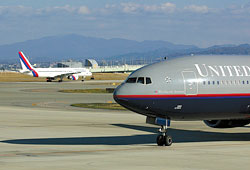 Nepal has got a reputation for being a cheap tourist destination.
Nepal has got a reputation for being a cheap tourist destination. Yeah, but only after you get there.
Airfares to and from Nepal are keeping tourists away even if they are willing to brave the negative publicity and come for a trekking holiday. For the price of a roundtrip ticket from Osaka to Kathmandu, a Japanese tourist can fly to Europe and back. Fares from Hong Kong to Nepal are more expensive than from there to Los Angeles.
"It is getting increasingly difficult to sell Nepal," says one Japanese trekking operator who is in Kathmandu this week with a Tibet-bound group. "More than the security situation, it is the high cost that deters many Japanese." She says her trekking clients compare costs, and find it much cheaper to fly to Peru or New Zealand.
The prices are abnormally high even on the Kathmandu-Delhi route, which costs $150 for a one-hour flight on economy class, although Nepalis and Indians only pay Rs 6,825. In comparison, the fare for a four-hour flight to the Gulf is $250. The reason: prices were kept artificially high by a bilateral state-owned cartel of Indian Airlines and Royal Nepal Airlines. But travel trade executives say now that Air Sahara and Jet Airways have started flights, fares are bound to come down.
Prices have dropped dramatically on sectors which have seen competition. Until six years ago, Kathmandu-London used to cost $1,200 roundtrip on coach on Royal Nepal Airlines' 'hopping flight' via Dubai and Frankfurt. Today, with Gulf Air, Qatar Airways, Austrian Airlines and Martinair all competing, prices have come down to $790.
"Our clients do complain that flights are expensive," admits Ashok Pokhrel of the Nepal Association of Tour Operators, who also runs Shangrila Tours, adding, "it is true that fares to Hong Kong and Japan are expensive." But other tour operators say there are special fares available, passengers just have to be smart and shop around.
For example, tickets are cheaper if they are bought in advance or in groups. Joy Dewan of Zenith Travels says: "Airlines operating to and from Nepal provide around 25 percent discount for tourists travelling in groups." But not all tourists travel in groups and many decide to go to take a spur-of-the-moment trip. As a result, they end up paying more.
Bhola Thapa of President Travels (see interview, pg9) says the main reason for high fares is because of monopoly or cartel pricing. "The Europe flights are the best example of competition between airlines bringing down prices. Shanghai, Lhasa and Hong Kong flights are examples of prices being high because there is only one airline flying," he adds. Thapa cites the example of deregulation in India's domestic travel which has slashed airfares to below railfares, with Deccan Airways, for instance, offering Delhi-Bombay for as little as IRs 900.
But there are also technical reasons why airfares out of Kathmandu are higher than elsewhere. There are takeoff load limitations at Kathmandu airport because of its altitude and short runway. A Boeing 777 departing for Bangkok must have at least 50 out of its 310 seats empty because it can't carry full payload on the three-hour flight. The load penalty is even higher when ground temperature rises to above 30 degrees on certain afternoons, reducing engine performance.
This is also the reason there are few direct long-haul flights from Kathmandu, as aircraft taking off with full fuel tanks would have load penalties that would make the sectors uneconomical. Austrian Airlines is the only operator flying a direct eight-hour flight to Vienna with Airbus 340s, but to do so it can't sell all its seats.
"There are three things that have to be factored in: altitude, temperature and length of runway, and on all three Kathmandu airport has limitations," says VK Shrestha, former chief instructor at Royal Nepal Airlines.
Unfortunately, there isn't much that can be done about this problem since the runway can't be extended without making an already steep approach path more difficult, says Shrestha. What all this means is that airlines have to charge more because their aircraft can't fly at optimum loads from Kathmandu.
With airfares going uop worlwide in response to a 70 percent increase in aviation fuel prices, this is also sure to hit flights to Kathmandu.
Then there are the very high landing fees at Kathmandu airport, which are among the highest in the world. When Lufthansa stopped its Frankfurt flight in 1998, one of the reasons it cited was high landing fees which made it difficult for the airline to break even. Lufthansa was the only airline that has used Boeing 747s on regular flights to Kathmandu. "Although some of the fees were reduced earlier this year, they are still high for the level of service provided," said one airline operator. The landing fee for a Boeing 757 in Kathmandu is $300, parking fee for three hours is $75, and then there is a $305 navigation fee. In contrast, landing in Bangkok is only $219 and parking is $15 per day. The fees are inevitably all passed down to passengers, and added to the airfares.
One way to reduce fares and boost tourism is by encouraging charter operators and new budget airlines like Singapore's Silkair or Tiger Air or Malaysian Air Asia to fly to Kathmandu. Says Pokhrel: "Encouraging competition and allowing more charter flights is the only way to reduce fares."


